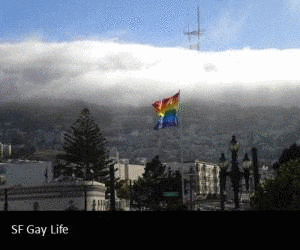San Francisco has an enormously powerful gay community, with 15.4% of the population identifying as gay or lesbian, the highest percentage of the 50 largest U.S. cities, according to the 2005 American Community Survey. On June 28, 1970, one year after the Stonewall Riots, it held the first gay pride parade in the country, which it continues to hold annually on the last Sunday of June. The Castro Street Fair in San Francisco’s gayest neighborhood, founded by Harvey Milk in 1974, was the very first annual street fair in the City.
Harvey Milk became the first openly gay man elected to public office in California when he was elected to the San Francisco Board of Supervisors in 1977. His assassination on November 27, 1978, along with Mayor George Moscone, made him a martyr and a symbol of the gay rights movement. After his assassination, openly gay Harry Britt was appointed and subsequently re-elected to his seat, and at least one openly gay or lesbian supervisor has served on the Board of Supervisors ever since.
In addition, an openly gay or lesbian person has represented one of San Francisco’s State Assembly districts since 1996, and an openly gay or lesbian person has represented one of the City’s State Senate districts since 2004.
But how did San Francisco’s gay community get to be so large, and so powerful? And how has that affected gay life in San Francisco?
Over time, SF Gay History will explore more about the history of San Francisco’s gay community as this site continues to grow and expand.

One revision: San Francisco held the second gay Pride parade in the United States on June 28, 1970. The first took place that same day starting two hours earlier in Chicago. The next day saw the parade in New York City followed by the one in Los Angeles. For a history of the first 10 years of the parade in San Francisco, see “Labor of Love: The Birth of San Francisco Pride, 1970–1980,” an online exhibition from the GLBT Historical Society Museum:
https://www.glbthistory.org/labor-of-love-info